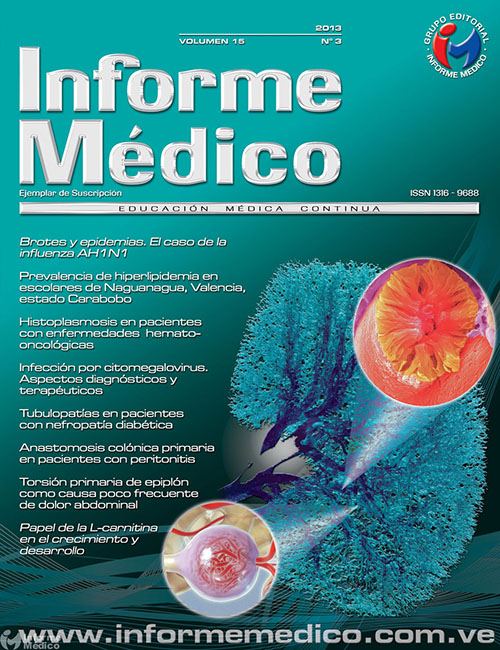Infección por Citomegalovirus. Aspectos Diagnósticos y Terapéuticos
Palabras clave:
Citomegalovirus, Infecciones virales, Pacientes inmunosuprimidos, Cytomegalovirus, Viral infectious diseases, ImmunodeficiencyResumen
La infección por citomegalovirus (CMV) es infrecuente, puede pasar desapercibida y no diagnosticada; tiene una prevalencia de 0,3 y 2% en los recién nacidos y 5 a 10% de los lactantes infectados en el útero. Afecta el SNC con letargo, convulsiones y calcificaciones intracerebrales. Puede haber secuelas como microencefalia, retraso psicomotor, sordera, hepatomegalia e ictericia. El citomegalovirus es el herpesvirus humano (beta) 5, familia Herpesviridae, subfamilia Betaherpesvirus; permanece latente sin ocasionar enfermedad, pero puede sufrir reactivación en casos de SIDA, quimioterapia o uso crónico de esteroides. La transmisión del CMV ocurre por el contacto de las mucosas con tejidos, secreciones y excreciones infectadas o contaminadas. La infección por CMV genera anticuerpos específicos; IgM al comienzo y posteriormente IgG. Los niños con infecciones ocultas por citomegalovirus tienen riesgo de presentar deficiencias en el desarrollo psicomotriz; la infección adquirida en épocas posteriores es generalmente asintomática, pero puede desencadenar un síndrome clínico similar a la mononucleosis infecciosa. El diagnóstico en el recién nacido se efectúa por aislamiento del virus, o por PCR del DNA viral en orina, sangre o LCR. La infección es tratada con los antivirales ganciclovir, valaciclovir, foscarnet, ciclofavir o fomivirsen.
Abstract
CYTOMEGALOVIRUS INFECTION. DIAGNOSIS AND THERAPEUTICAL ASPECTS
Cytomegalovirus (CMV) is not a frequent infection that can remain undetected and underdiagnosed; it has a prevalence of 0.3- 2.0% in newborn babies and in 5-10% of lactating babies infected in uterus, affecting the CNS with signs of lethargy, convulsions and brain calcifications. This infection may produce sequelae such as microencephaly, psychomotor impairment, deafness, hepatomegaly and ictericia. Cytomegalovirus is the human herpevirus 5, of the herpesviridae family that may remain as a latent infection not showing any signs or symptoms; however, the virus can be reactivated in case of AIDS, chemotherapy or chronic steroid administration. CMV transmission occurs via the mucosae contact with infected tissues, its secretions or through excretions coming from infected patients. The fetus may be infected within the uterus of a primary infected mother or in a mother with a reactivated infection. Postnatal CMV infection may happen during delivery of the newborn from mothers having the CMV in its vaginal channel. CMV infection generates specific antibodies; IgM at the beginning and thereafter IgG. Children with hidden CMV infection have increased risk of later in life psychomotor deficits. When CMV infection is acquired in older age, it is usually asymptomatic; however, in some cases it mimics infectious mononucleosis. Diagnosis of CMV infection in the newborn is documented by virus isolation or through CMV-DNA polymerase chain reaction done in urine, blood or CSF. Treatment is properly done with antiviral agents gancyclovir, valacyclovir, foscarnet, cyclofavir or fomyvirsen.

